Go back to Lecture 11
BACK TO DINOSAURS 1997 HOME PAGE
Lecture 12 - The Lias, Newark, Glen Canyon, and Stormberg Assemblages - Mass Extinction in the Beginning of the Age of Dinosaurs

Map of the Early Jurassic
Pangea was still mostly intact, although the rifting process was proceeding so that by 180 million years ago, the sea was working its way into the rift valleys formed between North America and Africa.
The four assemblages we will look at in this lecture are (above): 1), the Newark Supergroup, 2) the Glen Canyon Group; 3) the Stormberg Group; and 5) the Lias of England. Also shown is 4, the Lufeng Formation of China.
Triassic Provinciality
The distribution of various tetrapod groups during the Late Triassic is not at all uniform. This is despite the continuity of land in Pangea. We know that climate zonation was very pronounced during the Late Triassic, with a narrow humid equatorial zone and broad arid zones at roughly 30 degrees, north and south latitude. Humid temperate climates extended from around 50 degrees to the poles. During the Late Triassic, prosauropods had a distribution that corresponded roughly to the temperate zones of both hemispheres (although possibly not extending to the poles). A large range of large "amphibians" shared the prosauropods' ranges. Phytosaurs were limited to the northern hemisphere and the north-coastal portions of the southern hemisphere (i.e. India). Rauisuchians, crocodylomorphs, and aetosaurs seem to have been cosmopolitan, with some genera (if not species) seemingly global. In the equatorial region, the diversity of large "amphibians" was very, very limited, but ceratosaurian, and possibly ornithischian, dinosaurs were relatively common.
In plants the Dicroidim-dominated flora remained established in the southern hemisphere, while in the northern hemisphere the Late Triassic saw a rise in a group of seed-bearing conifers called the Cheirolepidiaceae or "cheiroleps". These plants ranged from in size from shrubs to large trees. They tended to have fleshy leaves and may well have been deciduous. Their rise coincides with the rise to prominence of the sauropodomorphs: first the prosauropods of the Triassic and Early Jurassic and then the giant sauropods, later in the Jurassic and Cretaceous. As the cheiroleps became less common though the Cretaceous, so did sauropods. However, the correspondence of the geographic distributions of plant and animals is far from perfect. During the Late Triassic, in India, the Late Triassic faunas resemble those of Europe, while the contemporary flora is of strikingly Gondwanan affinities.
Jurassic assemblages
By the Earliest Jurassic, the biological world had changed significantly. Most notable was a mass extinction event that wiped out a large proportion of both continental and marine animal diversity. First we will look at a number of classic tetrapod assemblages of Early Jurassic age, and then concentrate on the mass extinction event itself.
The Lias
The term "Jurassic" was first imposed on strata overlying the Triassic in the Jura Mountains of Europe. Strata recognized to be of Early Jurassic age came to be called the Lias in Europe, particularly England. While the Late Triassic sequence in Europe is largely continental in origin, that of the Jurassic, including the Lias, is largely marine, reflecting a broad encroachment of the sea over Europe in Early Jurassic time. A large number of marine tetrapods have been found in Liassic rocks in Europe, as well as one very important dinosaur.
A classic area for fossils of the Lias is the southern coast of Great Britain, particularly the town of Lyme Regis and its neighbor to the east, Charmouth.
Lyme Regis is the town made recently famous in the novel and movie, A French Lieutenant's Woman by John Fowles (who lives in the town). As were many English gentry, the male lead of the story, Charles (Jeremy Irons) is attracted to Lyme Regis by the famous Early Jurassic fossils where he falls in love with first Emestina (Lynsey Baxter) and then Sarah (Meryl Streep).
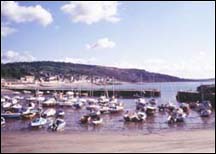 |
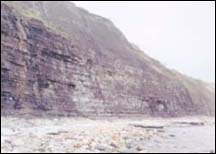 |
| Town of Lyme Regis from the Cobb, looking northeast. |
Cliffs of Liassic (Early Jurassic age) limestone, outcropping to the west of Lyme Regis. |
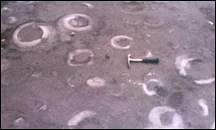
| 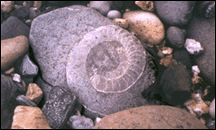 |
| Large Ammonites in situ in limestone, west of the Cobb, Lyme Regis. |
Large ammonite weathering on the beach, west of the Cobb, Lyme Regis. |
During the early 19th century Mary Anning became locally famous as a fossil collector in Liassic rocks. She collected many fine specimens which she sold to many a more wealthy paleontologist, notably Sir Richard Owen.The phrase, "She sells sea shells by the sea shore", is about Mary Anning. Anning found the first well-preserved ichythosaurs and the first plesiosaurs. |
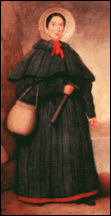 |
 |
| |
Mary Anning |
Bronze of Sir Richard Owen at the British Museum |
A later discovery in the Charmouth area was the nearly complete skeleton of an armored dinosaur Owen named Scelidosaurus in 1860 and 1861.
Scelidosaurus from Owen 1861.
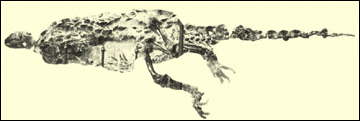
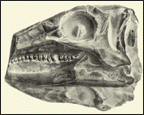
Skull of Scelidosaurus, from Owen (1861) |
The pelvis of Scelidosaurus is typically ornithischian. The skull is particularly interesting, however, because the tooth row is deeply inset. This deep concavity in the skull is almost certainly to support cheeks. This character turns out to be a major one for ornithischians and is a shared derived one for the group known as the Genasauria. Cheeks are important for keeping the food in the mouth when chewing. The armor consisting of plates or spines over the body is a shared derived character for a subgroup within the Genasauria, the Thyreophora ("shield bearers"). |

Reconstruction of Scelidosaurus, redrawn form Paul (1987). Armor is shown in brown.
The Stormberg
A series of Late Triassic and Early Jurassic sedimentary and volcanic rocks caps the Karroo basin sequence over much of southern Africa. This is the Stormberg Group, the basal part of which consists of Late Triassic coals and gray mud and sandstones, and the upper part of which is red beds and eolian dune sandstones and thick lava flows of Early Jurassic age.
The upper, Jurassic, part of the Stormberg has produced a rich fauna of advanced therapsids and mammals, turtles, sphenodontians (lizard-like diapsids), crocodylomorphs, and dinosaurs. Especially important are a series of fine skeletal remains of the early ornithischians Lesothosaurus and Heterodontosaurus.
Lesothosaurus is a small, very delicate ornithischian. Its pelvis is typically ornithischian, with a backwardly projecting part of the pubis. The forelimbs are delicate and there is a fully five-fingered hand, with relatively small digits.
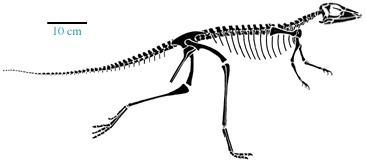
Reconstruction of the skeleton of Lesothosaurus. Modified from Weishampel and Witmer (1990).
Lesothosaurus, unlike Scelidosaurus, lacks the deeply inset tooth row. Although it probably had cheeks to some extent they could not have been as well-developed as in Scelidosaurus. This suggests to most authors that Lesothosaurus is the most primitive known of all ornithischians. In fact it is difficult to find characters that show that Lesothosaurus belongs to a monophyletic group.
| The peculiar, small, ornithischian Heterodontosaurus is known from the same beds as Lesothosaurus. Heterodontosaurus, however, differs markedly in the skull and hands. The skull does have the deeply inset tooth margin seen in Scelidosaurus. However, the tooth pattern is considerably more complicated. There are canine-like teeth in the upper and lower jaw in most specimens. The individuals lacking these teeth may be juveniles or a different sex. The teeth in the dentary and maxilla are arranged so that they make a blade-like apparatus. |
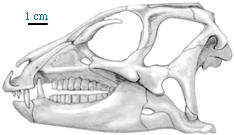 Skull of Heterodontosaurus. Based on Weishampel and Witmer (1990). |
The individual teeth have thicker enamel on the outside on the uppers and the inside on the lowers. This is a shared derived character with many later ornithischians and defines the monophyletic group, the Cerapoda. Many familiar dinosaurs such as the hadrosaurs ("duck-billed" dinosaurs) are within this very large group.
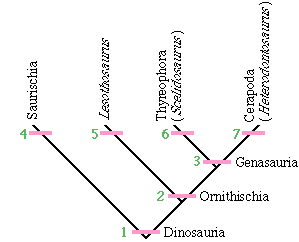 |
BASIC RELATIONSHIPS OF THE ORNITHISCHIA Together, Lesothosaurus, Scelidosaurus, and Heterodontosaurus provide characters that allow us to look at the relationships of major groups within the Ornithischia. The characters are: 1, open acetabulum; 2, backwardly directed process on pubis; 3, tooth row inset from jaw margin (cheeks); 4, enlarged and twisted digit I on manus; 5, no well defined shared derived characters; 6, armor on body as plates or spines; 7, enamel distributed differently on the sides of the teeth. |
The lower three quarters of the Stormberg has also produced a rich fauna of sphenodontians (lizard relatives), a turtle, mammals, very advanced cynodont therapsids (tritylodonts and trithelodonts), crocodylomorphs, and prosauropod dinosaurs, in addition to the dinosaurs mentioned thus far.
The uppermost part of the Stormberg Group consists of basaltic lava flows interbedded with sandstones. In one of the sandstones on an island in Lake Kivu, a large partial skeleton of what has been named Vulcanodon was found.
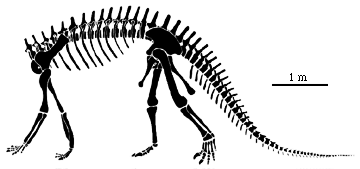
Reconstruction of the partial skeleton of Vulcanodon.
Although lacking a neck and head and much of the pelvis, the large relative size of the forelimbs and the structure of the hands and feet show that Vulcanodon was a sauropod dinosaur. The shared derived character of the Sauropoda, of which Vulcanodon is a member, is the addition of extra cervical vertebrae to the neck. This is done by moving the shoulder girdle posteriorly. More familiar examples of the Sauropoda include Brachiosaurus and of course Apatosaurus (AKA Brontosaurus).
| BASIC RELATIONSHIPS OF THE SAURISCHIA Now we can look at the basic relationships of the major groups of the Saurischia. The characters are: 1, open acetabulum; 2, enlarged and twisted manus digit I; 3, small head and peg-like teeth (and elongated cervical vertebrae); 4, backwardly directed process on pubis; 5, pelvic bones fused in adult; 6, functionally three-toed foot; 7, digits IV and V lost on manus; 8, apron-like pubis; 9, addition of extra cervical vertebrae to the neck. |
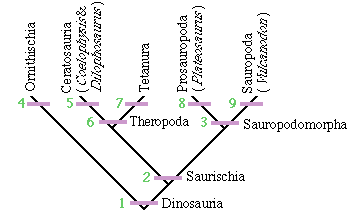 |
The Glen Canyon Group
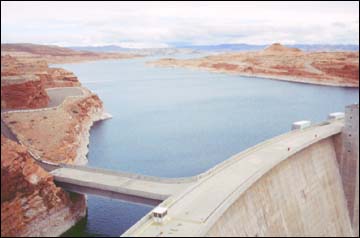
Glen Canyon Group strata at Glen Canyon Dam.
Lying on top of the Chinle Group over much of the western US is the Glen Canyon Group. Except perhaps for its basal-most strata, the Glen Canyon Group is of Early Jurassic age. Reptile bones are quite common in some portions of the group, especially the Moenave and Kayenta Formations. Frogs, apodans (more-or-less legless lissamphibians), turtles, mammals, tritylodonts, crocodylomorphs, and ornithischian and saurischian dinosaurs are represented by excellent material.
Skeletal remains of a small thyreophoran, Scutellosaurus, have been found. It closely resembles a very slender version of Scelidosaurus. In fact, very scrappy remains of Scelidosaurus itself have been found in the Glen Canyon Group.

The skeleton of Scutellosaurus with armor shown in brown. Modified from Colbert.
Most exciting is the discovery of several skeletons of the large ceratosaurian theropod dinosaur Dilophosaurus, found in the Navajo Nation near the village of Moenave, AZ.

Reconstruction of the skeleton of Dilophosaurus. Based on Paul (1988).
| Besides its considerable size, Dilophosaurus is characterized by having a large, although delicately constructed, double crest on its nose and forehead (hence the name).
On the right is a reconstruction of the head of Dilophosaurus. This is part of a full size model by the Rush Studios on display at Dinosaur State Park in Connecticut (see below). |
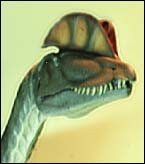 |
Dilophosaurus was prominently featured in the movie "Jurassic Park", in which the genus is pictured with an expandable neck frill and the ability to spit poison. Unlike virtually all of the other dinosaurs in "Jurassic Park", which were reconstructed larger than they really were, Dilophosaurus was made considerably smaller. While Dilophosaurus might have possibly been able to spit venom (for which there is no evidence anyway), it certainly did not have a frill.
Dilophosaurus is however very unusual in that its' skeletons have been found in relatively close proximity to footprints plausibly made by the dinosaur.
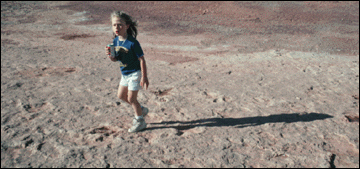
Track-bearing surface near the town of Moenave, AZ. An especially deep track can be seen in front of the running girl (for scale).
| The larger of the tracks are the right size and proportions for Dilophosaurus. They have been dubbed Dilophosauripus. However, they are clearly identical (although not as well preserved) to tracks found in abundance in eastern North America and named Eubrontes giganteus.
On the left is an example of one of the better Eubrontes (water filled) from the village of Moenave, AZ. Note the lens cap for scale (about 6 cm).
The Glen Canyon Group has produced many other kinds of footprints as well, most being the same kinds as in eastern North America. |
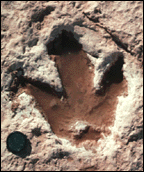 |
The Newark Supergroup
| The rift system that formed during the Triassic as part of the huge Atlantic rift zone continued to subside and accumulate sediment during the Early Jurassic. Although depauperate in good skeletal remains compared to the other deposits we will consider here, the rifts of eastern North America, containing the Newark Supergroup, are famous for the many tens of thousands of dinosaur tracks that have been found over the last 160 years.
The most famous of the early collectors and researchers to work on these footprints was Edward Hitchcock, who ultimately became President of Amherst College. From 1836 to 1865 he collected over 20,000 footprints of crocodilians and ceratosaurian and ornithischian dinosaurs. The bulk of these came from the Connecticut Valley rift basin of Connecticut and Massachusetts. Since that time an amazing number of dinosaur tracks have been recovered in Jurassic strata of the Newark Supergroup, from Virginia to Nova Scotia.
The very first track he described (1836) was Eubrontes giganteus, which was also the first dinosaur fossil to be described from North America. |
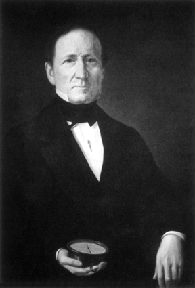 |
A particularly fine display of Eubrontes giganteus tracks is at Dinosaur State Park in Rocky Hill, CT. There hundreds of fine tracks are exhibited in situ.
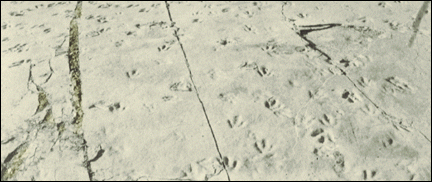
Eubrontes giganteus trackways at Dinosaur State Park.
Theropod dinosaurs walked along the shores of drying lakes in the Hartford basin rift valley. A slight increase in lake level allowed wave action to cover the tracks with sand without eroding the tracks themselves.
|
An example of a natural cast in sandstone of one of these tracks is shown on the right. Note quarter for scale.
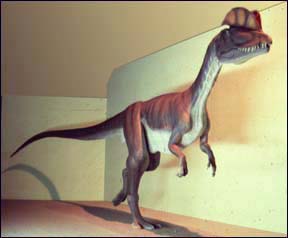
|
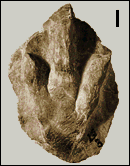
As part of the exhibit, they have a fine reconstruction of Dilophosaurus (on left). This model presently stands in front of an excellent mural depicting the Early Jurassic scene in which the tracks were formed. |
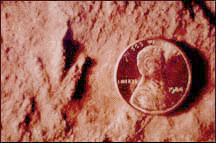
|
In addition to large theropod tracks, the Newark Supergroup has produced many smaller theropod tracks belonging to various track species of Grallator.
On the left is one of the very smallest ever found. It is a natural cast from Nova Scotia. (Photograph courtesy of Donald Baird.) |
There are two other major kinds of dinosaur tracks found in the Newark Supergroup. The most abundant of these is a small track that was certainly made by ornithischian dinosaurs similar to Lesothosaurus or Scutellosaurus.
| Anomoepus is the name given to the type of tracks seen at the right. When first found these were the source of much confusion for Hitchcock. On the right is one of the first dinosaur tracks to be recognized as not a bird. Hitchcock thought it was a kangaroo-like marsupial, but now we know it belonged to a small primitive ornithischian dinosaur. Note the hands and the heel marks made by the sitting animal. The specimen shown here is from the Deerfield basin in Gill, Massachusetts. |
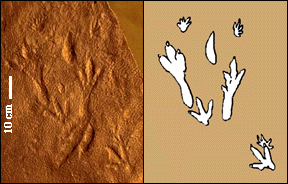 |
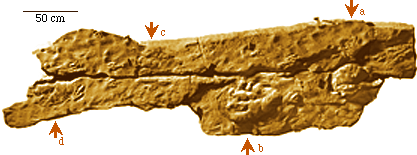
A much larger track is Otozoum moodii (above), first described by Edward Hitchcock in 1847. It was probably made by a large prosauropod dinosaur, most likely one of the types found in the Newark Supergroup. In the above trackway, which is a natural cast, "b" is the best track and indicates a dinosaur walking plantigrade.
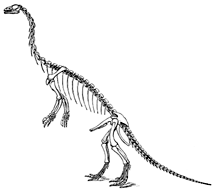 |
Skeletal remains have also been found in the Newark Supergroup Jurassic as well. The first examples found were described before the concept of the Dinosauria had crystallized.
These early skeletal remains were described by Edward Hitchcock and later by O. C. Marsh and given the names Anchisaurus (see left) and Ammosaurus.
These were prosauropod dinosaurs, similar to Plateosaurus. Partial skeletons have been found in Connecticut, Massachusetts, and Nova Scotia.
Skeletal reconstruction on left by Marsh. |
|
Much more recently abundant skeletal remains have been found in Nova Scotia. In addition to Ammosaurus and perhaps Anchisaurus are beautifully preserved material of sphenodontids, along with trithelodont synapsids, crocodylomorphs, and scrappy remains of ornithischians and theropods.
On the right is a nearly complete skull of a sphenodontian. Sphenodonts are lizard relatives. Very common globally in the Mesozoic, only one genus survives today, the Tuatara of New Zealand.
Surprizingly, the sphenodontid from Nova Scotia is indistinguishable from a species found in the Stormberg of Southern Africa. In fact, faunas of the Early Jurassic show remarkable homogeneity, and this contrasts strongly with the Triassic situation. |
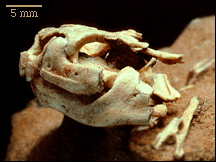 Photo courtesy of Hans Sues.
|
Mass Extinction at the end of the Triassic
There was an overall proliferation of forms through the Late Triassic with an overall increase in diversity, both in the oceans and on land. Many odd amniote groups, including giant rauisuchians, phytosaurs, and herbivorous aetosaurs, vied for dominance with the dinosaurs. However, at about 201 million years ago about 50% of all terrestrial vertebrate families were wiped out at the end of the Triassic, including the afore-mentioned non-ornithodiran groups. A similar mass extinction is seen in the marine record.
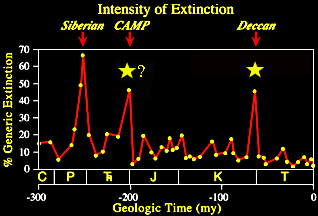
Graph of extinction rate against time for shelly marine invertebrates.
The sudden drop in animal diversity corresponds to a dramatic change in the plants, with a diverse plant community giving way to a very low diversity community almost entirely dominated by the cheiroleps (at least in the tropics) in the earliest Jurassic.
| An especially detailed record of the continental aspects of this mass extinction is preserved in the Newark Supergroup. In large part, this is because of the time control afforded by ubiquitous sedimentary cycles. These cycles record the rise and fall of lakes that periodically filled the rift valleys. The rise and fall of the lakes was, in turn, under the control of climate cycles governed by celestial mechanics. The most obvious of these cycles is one that has a period of about 20,000 years.
On the right is a photo of one of these cycles in the Hartford basin. The black layer is the deepest water unit and the gray layers on either side are shallow-water units. The red beds are very shallow sediments formed when the lake was mostly dry. |

|
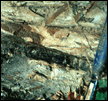

|
A very thin layer (upper left) has been found in the Newark basin in Pennsylvania that has almost nothing but fern spores in it (right). Ferns are often the first colonizers after a catastrophe and the appearance of this so called"fern spike" in the fossil pollen and spore record appears to be an indication of a major ecological disaster.
Below the layer with the fern spike, pollen and spore assemblages are diverse. Above it, one pollen taxon dominates up to 99 percent of the microflora. That form is Corollina (or Classopollis) (lower left), and it was produced by the Cheirolepidiaceous conifers. |
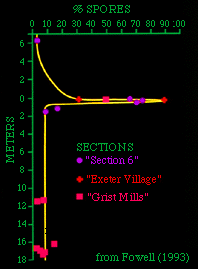 |
|
This began a dominance that would last until about 120 million years ago, a span of over 80 million years.
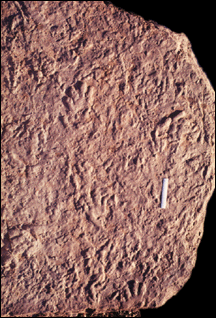
| Abundant reptile footprints in the same area show a massive change in taxonomic composition right at the same layer. At the same locality where the fern spike is observed, there are typical Triassic footprint forms within a few meters of the boundary.
On the left is a spectacular slab (natural cast) of dozens of trackways. Most obvious are tracks of medium to large sized tracks of Brachychirotherium, most likely made by a rauisuchian. Also are many three-toed, small- to medium-sized theropod tracks (Grallator and Anchisauripus). The larger of the dinosaurian tracks are the largest we see in the Triassic. Scale is 25 cm. Found by Mike Szajna and Brian Hartline. Photograph courtesy of Brian Hartline.
Footprint assemblages above the fern spike and correlative layers elsewhere completely lack the Triassic forms. It is not until these layers that we get the large theropod tracks of the Eubrontes type. |
|
In Austria and Italy, what is probably the same layer as the fern spike layer in the Newark basin, has grains that have been identified as "shocked quartz". Shocked quartz is known only from known asteroid impact sites and nuclear bomb test sites. It is produced by very high, but short-lived, pressures. This suggests that the Triassic-Jurassic boundary was caused by the impact of a giant asteroid similar to the one that terminated the Cretaceous Period. But in this case, rather than wipe out the dinosaurs, the Triassic-Jurassic mass extinction may have opened the doors for the dinosaurs by wiping out their competition. The dinosaurs would have taken over by default!
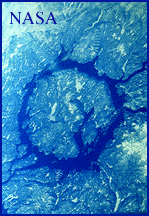 |
A candidate for an impact event that could be the cause of the Triassic-Jurassic mass extinctions is the great Manicouagan impact structure of northern Quebec, Canada. This gigantic structure formed about 200 million years ago by the impact of a ~10 km diameter asteroid. The Manicouagan structure produced by this impact is easily visible from space and consists of a ring of shattered rock 70 km in diameter surrounding a disk of rock that was completely melted by the impact event. About 1 km of rock has been eroded from the site since the impact and its original size may have been about 100 km in diameter. The amount of energy released by this impact was probably about 10,000 times the combined energy that would be released by the simultaneous explosion of the entire nuclear arsenals of the United States and former Soviet Union!
Although a possible candidate for the cause of the end-Triassic mass extinction, the newest dates suggest that the Manicouagan impact structure could be about 12-15 million years older than the mass extinction itself, thus ruling it out as a causal agent. A different impact is still possible. |
A huge eruption of lava flows occurred over about a 600,000 year time span near the Triassic-Jurassic boundary. It probably marks the very beginning of sea-floor spreading and formation of oceanic crust near Florida. This is one of the largest igneous events known. It is quite possible that CO2 emissions or sulfur aerosols associated with these lava flows may also have been associated with the Triassic-Jurassic mass extinctions. It is even possible that both an impact and volcanism could have been responsible. A similar pattern occurs at the Cretaceous-Tertiary boundary, which we shall discuss in later lectures.
REFERENCES
Fowell, S. J. 1993, Palynology of Triassic/Jurassic boundary sections from the Newark Supergroup of Eastern North America: Implications for catastrophic extinction scenarios [Ph. D. Thesis]: New York, New York, Columbia University, 133 p.
Owen, R., 1861, A monograph on the fossil Reptilia of the Lias Formations. I Scelidosaurus harrisonii. Palaeontograhical Society Monograph, v. 13, p. 1-14.
Paul, G. S., 1987, The science and art of restoring the life appearance of dinosaurs and their relatives. in Czerkas, S. J. and Olson, E. C. (eds.) Dinosaurs Past and Present, Vol. II, Natural History Museum of Los Angles County, p. 5-49.
Paul, G. S., 1988, Predatory Dinosaurs. New York, New York Academy of Sciences, 464 p.
Weishampel, D. B. and Witmer, L. M., 1990, Lesothosaurus, Pisanosaurus, and Technosaurus. In Weishampel, D. B., Dodson, P., and Osmolska, H. (eds.), The Dinosauria., University of California Press, Berkeley, p. 416-425.
Go to Lecture 13 (the practice midterm)
Go to Lecture 14 (next lecture: Late Jurassic)
BACK TO SYLLABUS
BACK TO THE DINOSAUR AND THE HISTORY OF LIFE HOME PAGE



































